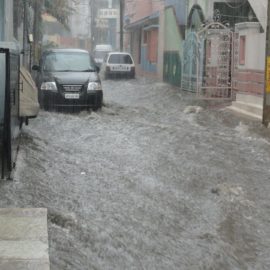
FEMA has been buying houses for a long time.
For the past 30 years, the Federal Emergency Management Agency, or FEMA, has been conducting a vast, real-world experiment in climate adaptation. Using money from a little-known grant program, the agency has doled out billions of dollars to states and cities that want to tear down flood-prone homes. These local governments have paid vulnerable homeowners to leave flood-prone properties and move elsewhere, in a process known as “managed retreat.” These homeowners have used FEMA money to move back from coastal areas and river basins from New Jersey to Texas to Iowa, usually fleeing in the wake of major floods and storms. But even though the buyout program has become the government’s primary tool for encouraging managed retreat, FEMA has never kept tabs on what happens to buyout participants after they leave their homes. As a result, there is scant information about how effective the program is at reducing flood risk — or about where these first waves of American climate migrants have gone. A few years ago, researchers at Rice University set out to change that. In a new study published this week, they match federal records with private consumer address data to trace the path of almost 10,000 buyout households that have taken FEMA money, or around a quarter of all program participants. The study offers the clearest picture yet of how the buyout program works, and the strongest evidence so far that it reduces the risk that climate change has brought to American shores. While the findings show that most buyout homeowners move only short distances, they prove that those participants actually do seek new homes with substantially lower flood exposure. But the study also finds that program outcomes look very different depending on the racial makeup of a given neighborhood. Homeowners in majority-white areas tend not to take buyouts unless the areas around them face extreme levels of flood risk, while homeowners in other neighborhoods are more likely to take buyouts even when the risk is more moderate. And when homeowners in white neighborhoods do take buyouts, they overwhelmingly seek new housing in other majority-white areas in the immediate vicinity of their old homes. “Any time a color-blind policy enters a racialized housing landscape, it’s going to be segmented,” said Jim Elliott, a professor at Rice University and the lead author of the study. “The same policy is going to work differently in different places.”
grist.org
The first difference is who takes the buyout.
The first difference is in who takes buyouts in the first place. By analyzing the flood risk levels of all the areas where households took FEMA money, Elliott found that the majority-white buyout areas were much deeper in the floodplain than majority-Black and majority-Hispanic buyout areas: The average majority-white buyout area had an almost 90 percent chance of flooding by 2050, compared to as low as around 50 percent for majority-Black buyout areas. This suggests that white households only participate in the program when the flood risk around them is severe, and otherwise tend to stay put. Elliott points to a few reasons why households in majority-white areas might hang on longer. For one thing, local governments tend to spend more money on flood control infrastructure in areas with higher home values, which may assuage residents’ concerns about future risk. For another, households in these areas may have more luck selling their homes on the private market. Homeowners in majority-Black and Hispanic areas, meanwhile, may have no option but to take buyouts. The destinations of migrating households also differed based on the racial composition of the neighborhoods they were leaving behind. More than 95 percent of buyout households in majority-white census tracts ended up moving to other majority-white census tracts. Residents of majority-minority neighborhoods were far more likely to move to a new neighborhood with a different demographic composition: Just 40 percent of buyout households in majority-Hispanic areas moved to other majority-Hispanic areas, and only 48 percent of buyout households in majority-Black areas moved to majority-Black areas.
The study looked at the specific composition of the neighborhoods.
The study only identifies the racial composition of neighborhoods where buyouts happen, rather than the racial identities of individual households, but Elliott has a theory about what’s going on: He believes the data shows white families in all neighborhoods using buyout money to move to wealthier and whiter areas. When the white families are leaving behind majority-white areas, they seek out other white areas, and when they’re leaving majority-Black or majority-Hispanic areas, they’re engaging in a process similar to the “white flight” housing exodus of previous generations. “If you’re approaching a majority-white neighborhood, and you want people to move, they’re going to move if and only if they can meet three conditions,” said Elliott. “They have to have housing somewhere nearby, they want to reduce their flood risk, and the close-by safer housing has to be in a majority-white area. They’re not going to sacrifice that.” In a previous paper that focused on Houston, Texas, Elliott found that white families in racially diverse areas were far more likely to take buyout offers from the government than were their Hispanic neighbors in the same areas.
This forms a picture of what the FEMA buyouts does.
These results offer a mixed picture of the FEMA program, which has become an essential tool in the federal government’s climate adaptation arsenal. On the one hand, it affirms that people who take buyouts do end up in safer homes rather than hopping from one flood-prone area to another, as many experts have feared they do. This benefit is strongest in large cities, where buyout households have access to relatively ample housing stock and can find safe new homes that are closer to their old ones. On the other hand, though, FEMA money seems to grease the wheels of pre-existing processes of white flight and urban segregation, allowing white households to leave behind diversifying neighborhoods and entrench themselves in other white suburbs and towns. A spokesperson from FEMA said the agency strives for equity in its mitigation programs. “While FEMA does not base its assistance or programs on race, national origin, or socioeconomic status, Administrator Criswell has directed the agency to look at all our programs to determine areas where we can break down barriers, enhance equity, and increase accessibility,” the spokesperson said. “This incudes, but is not limited to, requiring states to consider equity and the impacts of climate change when implementing flood buyouts and other hazard mitigation programs.”
The recommendation was to not only continue the program but build it up.
Elliott said these results suggest that the buyout program should be bolstered and expanded, with additional stipends that allow lower-income households to move to a wider variety of new types of housing. Furthermore, he argues, FEMA should do much more to monitor the outcomes for these de facto climate migrants as the agency continues to pour money into adaptation and buyouts. “The policy lesson is really that it’s not just the environmental risk and the way the policy works that’s intervening to affect how it plays out for homeowners,” he said. “We need to engage communities more proactively and think about not only when they retreat, but how they retreat.”
Rising seas will make this an expensive program. How do you buy out a Miami or New York?



